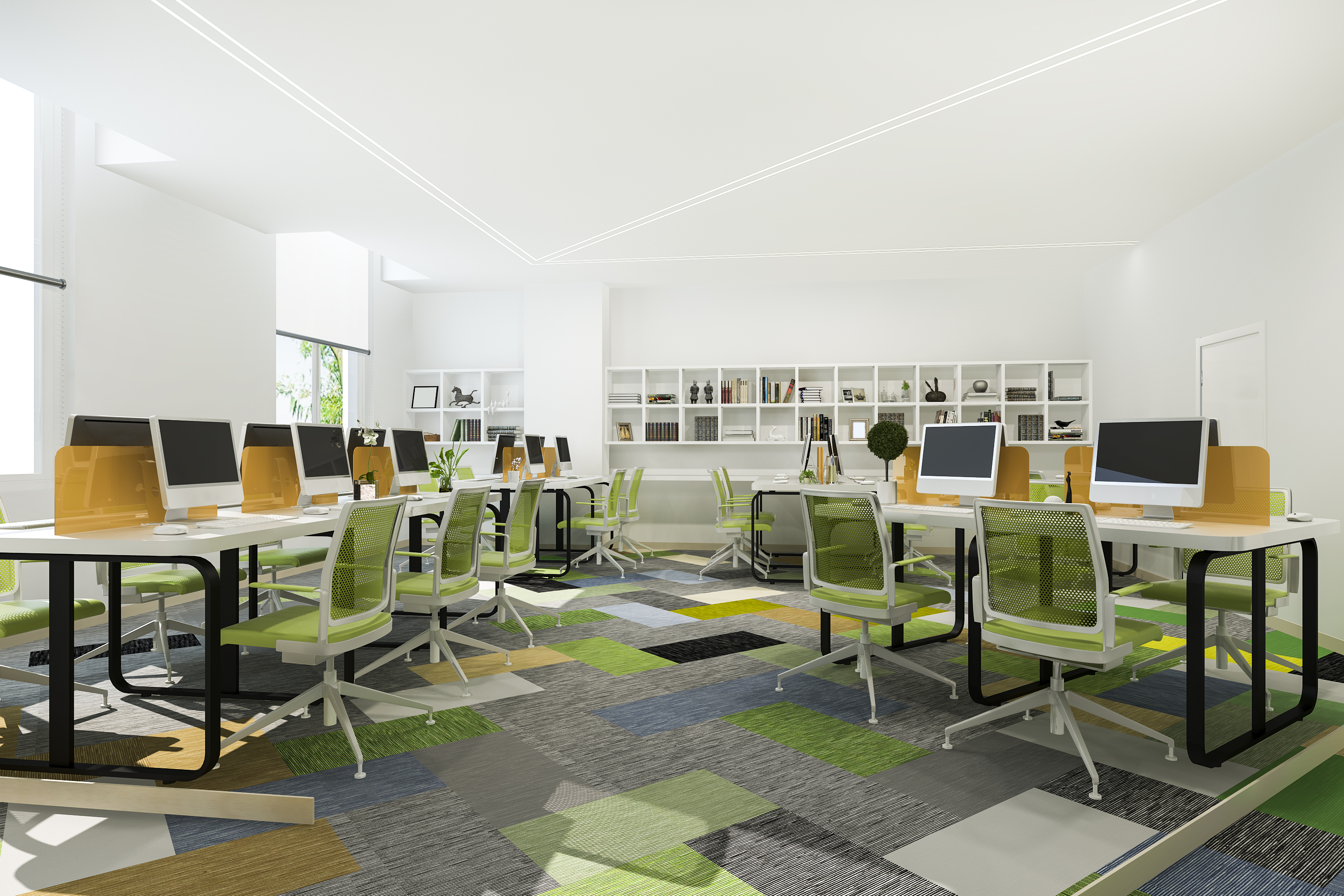
Improve Your Work Environment with Office Space Utilization
Maximizing office space utilization has become a priority for organizations aiming to boost productivity and reduce operational costs. The way businesses use their office space directly impacts employee experience, real estate costs, and overall efficiency.
Understanding office space utilization metrics and applying the right strategies can change and upgrade how companies manage their physical spaces.
In this article, we’ll dive into the details of space utilization, the metrics involved, and how businesses can measure and improve space usage to achieve better results.
What Is Office Space Utilization?
Office space utilization refers to how efficiently the available space in a workplace is being used. This involves analyzing how much space is occupied versus how much is underutilized.
Space utilization is more than just ensuring employees have enough room, it’s about aligning the workspace with the organization’s goals and improving overall efficiency.
Why Does Office Space Utilization Matter?
Effective office space utilization matters for several reasons:
- Cost savings: By improving space utilization, businesses can save money on corporate real estate costs. Companies that calculate office space utilization and make data-driven adjustments can reduce the need for larger workspaces, lowering their overall real estate budget.
- Boosting employee productivity: An office layout that supports employee needs, whether through collaborative spaces or private offices, can improve productivity and well-being. Providing the right mix of space types encourages collaboration, increases focus, and enhances the employee experience.
- Reducing wasted space: Underused spaces, like empty conference rooms or rarely used meeting rooms, are a drain on resources. Businesses can improve their space utilization rate by repurposing unused areas into more functional spaces, such as shared workspaces or quiet zones.
- Enhancing organizational efficiency: A well-used office leads to organizational efficiency by ensuring that space is aligned with business needs. Facilities managers who regularly measure space utilization can make better decisions about office layouts, improve operational flow, and reduce wasted real estate.
A poorly utilized office space, on the other hand, can lead to wasted real estate, lower employee engagement, and higher operational costs.
How to Measure Office Space Utilization Metrics
Understanding and tracking office space utilization metrics is the foundation of improving how your business uses space.
By looking at the numbers, companies can make data-driven decisions that enhance productivity and reduce wasted real estate.
1. Space Utilization Rate
This metric shows the percentage of total office square footage that is actively used. The formula to calculate the office space utilization rate is:
Space Utilization Rate = (Total Space Used / Total Available Space) x 100
For example, if you have 10,000 square feet of office space and only 7,500 square feet are in regular use, your office utilization rate would be 75%. This indicates that 25% of your office space is underutilized.
2. Cost Per Person
Calculating the cost per person helps determine how much actual usage of space is needed for each employee. This metric includes factors such as rent, utilities, and other operating costs.
Dividing these costs by the number of employees allows you to assess whether the office space is being used efficiently.
3. Peak Utilization Rate
This refers to the highest percentage of space occupancy during the busiest times of the day or week. Monitoring peak utilization helps identify whether certain areas, like meeting rooms, are overbooked or if there are underutilized spaces during peak hours.
4. Room Capacity and Occupancy
Meeting rooms and shared spaces often account for a significant portion of office real estate, including valuable square footage. Tracking the capacity and actual occupancy of these spaces is crucial for efficient space utilization.
For instance, if larger meeting rooms are constantly underutilized, they may be repurposed into smaller collaboration zones.
Measuring Space Utilization: The Right Tools and Technologies
Accurately measuring office space utilization requires the right tools and technologies. Here’s how modern tools can help track and improve space utilization and overall space usage:
Sensor Systems for Real-Time Data
Sensor systems offer real-time monitoring of space usage. These systems track when rooms are occupied and how long they are used. They can also measure the amount of space being used in open office areas.
With up-to-date information from sensor systems, businesses can adjust their office layouts and make informed decisions about reallocating space.
Room Booking Systems
Room booking systems allow employees to book meeting rooms and shared spaces in advance. These systems also provide valuable data on how often these spaces are booked, ensuring there is no underutilized space.
By tracking average peak utilization, businesses can ensure that meeting rooms are used efficiently, prevent overbooking, and improve the meeting room experience by allowing employees to see real-time availability.
Data-Driven Insights Through Workplace Analytics
Workplace data analytics platforms analyze the usage of different workspaces and provide actionable insights.
With the help of data-driven decisions, facilities managers can monitor trends, identify underutilized spaces, and make changes to optimize office layouts.
2 Strategies to Improve Office Space Utilization
Improving office space utilization requires a combination of monitoring, data analysis, and strategic planning.
Businesses can create more efficient, productive, and cost-effective workplaces by identifying underutilized areas and making data-driven decisions.
Let’s explore key strategies for improving office space utilization.
1. Identifying Underutilized Spaces
One of the first steps in improving space utilization is identifying areas of the office that are underused.
Underutilized spaces can include conference rooms, meeting rooms, or shared workspaces that remain empty during peak hours.
Tools and Techniques for Spotting Underutilized Spaces
- Sensor systems: Installing sensor systems throughout the office provides real-time data on which areas are occupied. These systems can track how often a particular space is used and for how long, helping you understand space management patterns.
- Room booking data: Analyze data from room booking systems to see which meeting rooms are frequently booked and which ones remain empty. Tracking these important metrics can reveal whether conference rooms are appropriately sized or need to be repurposed.
- Surveys and observations: Conduct employee surveys to gather feedback on space usage. Observing how employees interact with their environment can also provide insights into how much space is needed and which areas are underutilized.
2. Redesigning Office Layouts for Better Space Utilization
Once underutilized areas are identified, the next step is to redesign the office layout to improve space usage.
A well-planned office layout can accommodate a range of work styles and activities while maximizing the available space.
Creating Flexible and Adaptable Office Layouts
- Open office design: Open office layouts encourage collaboration and allow for flexible seating arrangements. This design reduces the need for private offices and maximizes the use of shared spaces.
- Multi-functional spaces: Create multi-functional meeting rooms or conference rooms that can serve multiple purposes, such as formal meetings, casual brainstorming sessions, or even quiet zones.
- Hot desking: Implement hot desking systems where employees can reserve workstations as needed. This reduces the need for dedicated desks, freeing up space for more collaborative spaces.
- Meeting room flexibility: Make sure meeting rooms of different sizes are available to match actual space needs. For instance, larger meeting rooms should be repurposed if smaller teams frequently use them.
How to Use DeskFlex to Optimize Your Office Space Utilization
DeskFlex is an all-in-one solution designed to help businesses manage their workspaces efficiently. From reserving meeting rooms to optimizing workspace layouts, DeskFlex ensures that every square foot of your office is being used effectively.
Whether you’re working in a traditional office setup or managing a hybrid workspace, DeskFlex provides the tools necessary to maximize space management.
Here’s how to get the most out of your office spaces using DeskFlex:
1. Set Up Detailed Space Profiles
With DeskFlex, you can create comprehensive profiles for every office space, including conference rooms, shared spaces, and private offices. Each profile can include important details, such as:
- Define how many people the space can accommodate.
- Include information about equipment like projectors, whiteboards, or video conferencing tools.
- Provide a detailed map of where the space is located within the office.
2. Monitor Real-Time Space Occupancy
DeskFlex provides real-time space occupancy data, allowing you to monitor which meeting rooms or workspaces are in use at any given moment.
Employees can check the availability of spaces from their desktop or mobile devices, eliminating confusion and preventing double bookings.
Real-time data ensures that underutilized spaces can be quickly identified and repurposed, helping facilities managers make more informed decisions about how to allocate space.
3. Book and Manage Spaces Remotely
DeskFlex’s mobile app offers full functionality, allowing users to book and manage spaces remotely. Employees can:
- Reserve workspaces in advance or make last-minute changes on the go.
- Check-in to reserved spaces directly from their mobile device.
- Cancel bookings if their plans change.
4. Automatic Space Release for No-Shows
DeskFlex’s automatic check-in system ensures that reserved office spaces aren’t left idle. If an employee forgets to check in, the system will automatically release the space, making it available for others to use.
5. Integration with Microsoft Office 365 and Outlook
DeskFlex integrates smoothly with popular office tools Microsoft 365 and Outlook. This allows users to:
- Schedule and manage office spaces directly through their Outlook calendar.
- Receive automatic notifications about space availability and upcoming reservations.
- Sync reservations across multiple platforms, avoiding scheduling conflicts.
With this integration, managing office spaces becomes part of the daily workflow, ensuring a seamless experience for employees.
6. Optimize Space with 3D Floor Maps
DeskFlex’s 3D floor maps allow employees to visualize office layouts in real time. This feature helps them:
- Choose the most convenient spaces based on their location within the office.
- Identify underutilized areas or shared spaces that may be more suitable for their tasks.
9. Touchscreen Displays for On-the-Spot Bookings
DeskFlex also offers touchscreen displays that can be installed outside meeting rooms or collaborative spaces. These displays allow employees to:
- View real-time room availability.
- Reserve spaces on the spot.
- Check-in to rooms quickly and easily.
10. Cost Savings and Space Efficiency
By optimizing how office spaces are used, DeskFlex can significantly reduce operational costs. Businesses can avoid leasing additional real estate by making better use of existing spaces, such as meeting rooms, conference rooms, and shared spaces.
With insights provided by space utilization metrics, companies can make the most of every square foot, leading to long-term cost savings.
Optimize Your Office Space Utilization with DeskFlex
DeskFlex goes beyond standard space management—it’s an all-encompassing solution that ensures your office operates smoothly.
Whether you’re managing meeting rooms, avoiding double bookings, or maximizing space utilization, DeskFlex makes it easier to control your workplace resources.
But the benefits of DeskFlex extend beyond just managing conference rooms. It caters to hybrid workplaces and offers various features tailored to different industries. DeskFlex includes:
- Desk booking: Allow employees to reserve their desks in advance, promoting flexibility and better space utilization.
- Visitor management: Control and monitor who enters the office, from clients to delivery personnel.
- Lobby kiosk: Simplify resource management with an easy-to-use interface that displays the status of desks, meeting rooms, and other shared spaces in real-time.
DeskFlex empowers businesses to optimize office layouts, reduce wasted space, and improve the overall employee experience.
Book a demo today and discover how DeskFlex can streamline your office utilization!
FAQs About Office Space Utilization
What is the average office space utilization rate?
The average office space utilization rate generally ranges between 60% to 70%. This means that, on average, only about two-thirds of office space is actively used. A lower utilization rate may indicate wasted space, while higher rates suggest efficient use. However, ideal utilization rates can vary depending on the business model and office layout.
How to utilize office space?
To efficiently utilize office space, businesses should analyze space usage metrics, such as occupancy rates and peak utilization. Implementing flexible workspaces, shared desks, and multi-purpose meeting rooms can help maximize office space. Additionally, technology like room booking systems and sensor systems can track space occupancy in real time, ensuring better space management.
What is an example of space utilization?
An example of space utilization is transforming underutilized meeting rooms into collaborative workspaces. For instance, if larger conference rooms are rarely filled to capacity, companies can repurpose these rooms into smaller zones that accommodate teamwork or quiet workspaces. This ensures that every square foot of the office is put to productive use.
How do you calculate office Utilisation?
Office utilization can be calculated by measuring the percentage of office space that is actively used. The formula is:
Space Utilization Rate = (Total Space Used / Total Available Space) x 100
For example, if a business has 10,000 square feet of office space, and 7,500 square feet is consistently occupied, the utilization rate would be 75%. This helps businesses identify underutilized areas and make informed decisions to improve space efficiency.



















































